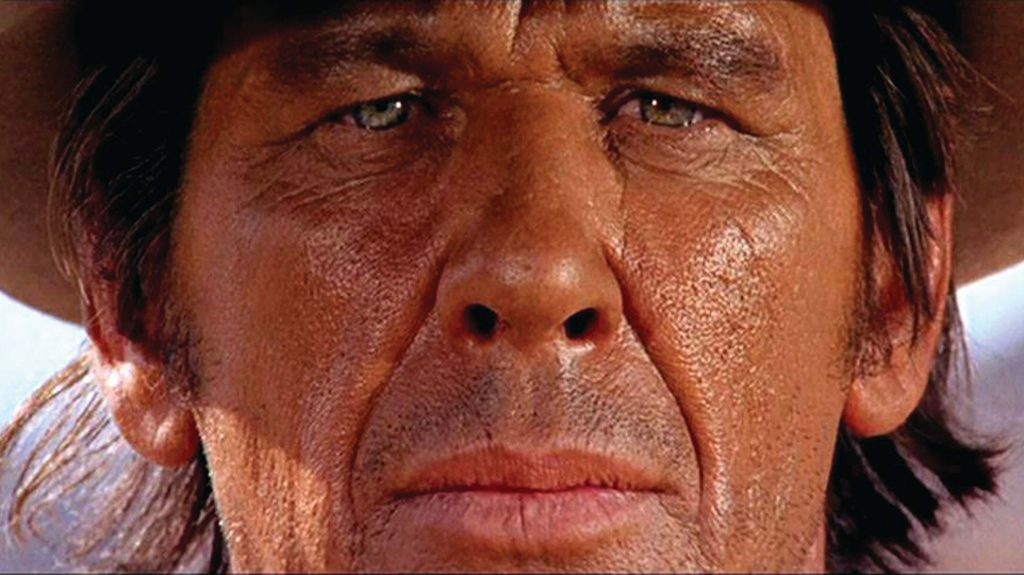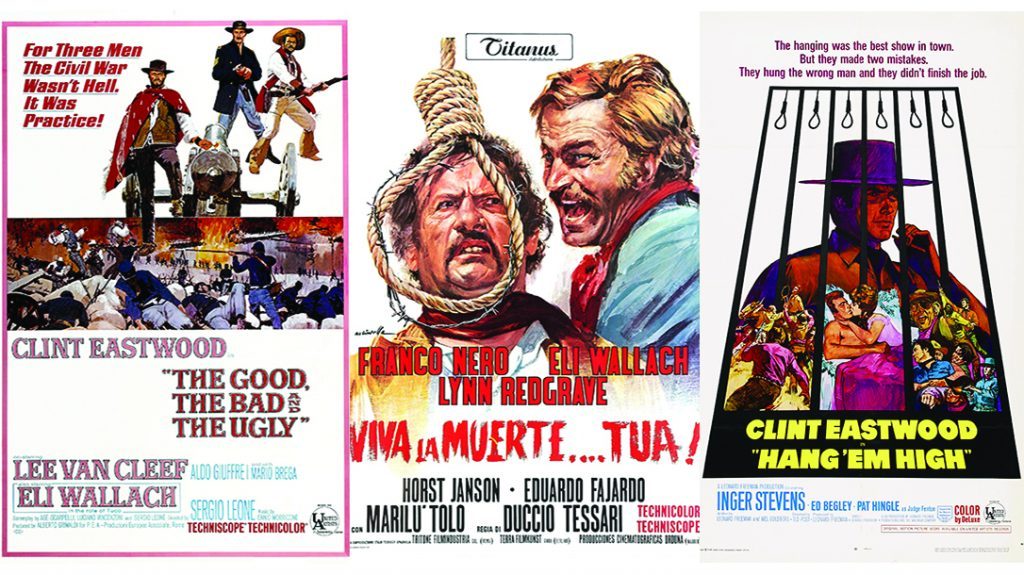The scene is iconic; the camera angles are unmistakable. Two leathery-skinned men staring at each other with a thousand-yard gaze, trying to predict movement, quivering with murderous anticipation, ready to strike down the other in a flash of small-arms glory. Blowing wind, shallow breathing, and a horse stomping the dusty ground in the distance. High tension fills the soundtrack. A high-pitched, wavering whistle. And then BANG! Armageddon commences.
Spaghetti Western Magic
That generally sums up the climax of every story arc in what has become known as the Spaghetti Western; it’s a film genre about the violent times in the Old West, produced by Italians and Spaniards in the 60s and 70s. Ask any red-blooded American to name their favorite Westerns, and invariably you will hear titles such as “The Good, the Bad and the Ugly,” “A Fistful of Dollars,” “For a Few Dollars More,” “Hang ’Em High,” “High Plains Drifter,” “The Outlaw Josey Wales” and “Death Rides a Horse.”
But why were over 500 of these films produced in such a short period? What was the appeal of this seemingly endless list of movies? Most of them were low on script and high on poorly overdubbed dialogue. So why the intrigue? Simple. They speak to our souls. They tap into that certain place in every man who wishes he could be on the frontier. Living life under the stars, a wheel gun in his hand, hate in his heart, with the occasional visit to a brothel to get the poison out.
It’s easy to say that Sergio Leone, “The Godfather of the Spaghetti Western,” stood on the shoulders of other Italian artists like Federico Fellini and pioneered a whole new genre of movie, but there is nothing new about the Western.
For as long as film has been available, filmmakers delivered stories of the American West to rabid audiences. They became insanely popular in the silent film days. By the 1930s, however, audiences wanted more, and major stars would soon appear.
Enter Clint Eastwood
While there were a few Hollywood Western films in the 40s and 50s, Leone released “A Fistful of Dollars” in 1964 and set the world on fire. It sharply departed from the art-house Italian films of the time. Intending to cater to the European market that hungered for American Westerns, Leone wanted to reignite storylines and character-driven plots rather than play by Hollywood’s tired rules. Henry Fonda was originally chosen as the “The Man with No Name,” as was Charles Bronson. However, due to budget constraints and actors thinking the script was junk, Leone resorted to scouring a list of lesser-known available actors until finally choosing TV’s “Rawhide” cast member Clint Eastwood.
You can sit on a barstool all day and argue over who plays the best cowboy character in the film, but if you don’t argue for Eastwood, you’re just plain wrong. It’s hard to imagine anyone else playing the roles that he did with such a convincing mix of cold-blooded murderous rage, humor, and indifference to everyone else on the planet. Guys like Lee Van Cleef, Charles Bronson, Franco Nero, and Terence Hill had fabulous careers and made windfalls from these films, but Eastwood is the quintessential hero.
The Wild, Wild, West
“Fistful” exploded, even though it is widely considered a direct rip-off of Japanese director Akira Kurosawa’s “Yojimbo.” In fact, Leone had to share some profits from the film with Kurosawa because it was so blatantly stolen. Legal troubles aside, Leone was on to something. He immediately recognized the potential of his films and started down the path to immortality. He quickly followed up “Fistful” with two more films in the “Man with No Name” trilogy: “For a Few Dollars More” and “The Good, the Bad and the Ugly.” “Few Dollars” is my personal favorite in the trio, but “The Good” is widely considered to be the best-loved film of all.
Early Spaghetti Western films were often driven by similar plot devices. Some nameless, horse-riding protagonist wanders into a lonely Western town. The townsfolk are almost invariably under the bootheels of a gang of thugs or else have something that the bad guys want, such as gold, money, or the town itself. Local law enforcement is cowardly, ready to give up a badge at the slightest hint of trouble. Typically, the hero would befriend a sidekick — a coffin maker or a crazy old miner that helped to fill in the thin plot between gunfights. Soon, some sort of deception, double-crossing, or plan to overthrow the gang would emerge. And then people would start dying. A LOT of people. Finally, the hero walks away with the money or the girl or just a half-smoked cigar. The end.

Beyond the Plot
Of course, we use the term “hero” loosely. Usually, the primary character was an antihero: Greedy and heartless, with the skills to shoot a hair of a moving gnat’s ass at 50 yards. Therein lies the appeal of a lot of these films. Audiences had grown tired of the same corny, cattle-driving pulp that Hollywood was churning out. These Westerns were dark thrillers full of gunfights. They left the viewer wondering if the “hero” was truly a good person or just the devil incarnate.
Regardless, directors repeated this general plot structure for decades (and you thought a single “Batman” reboot was bad). Over the years, sub-genres came and went. They often reflected the political climate of the times (see Sergio Sollima’s “The Big Gundown”). Or they would highlight social issues or be just shot (pun intended) in a different format altogether, as in the more slapstick style of Enzo Barboni’s “They Call Me Trinity.” The films became such an iconic part of the cinematic scene that Mel Brooks’ “Blazing Saddles,” while not a true Spaghetti Western in any way, was a completely hilarious sendup of every cliché used in those films. Beans anyone?
So, if you can suspend your disbelief while watching these movies, they can be a lot of fun. We’ve compiled a list of things to watch for when experiencing a Spaghetti Western for the first time. Our suggestion is to watch the Leone films initially to immerse yourself in the style of that day. A well-versed Western lover of the genre can spot these plot hacks in your favorite films.
Musical Masterpiece
Ennio Morricone was THE composer for Spaghetti Westerns. He was like the Dr. Dre or Rick Rubin of the day for these films. Not only were the thematic scores astounding, but they crafted the emotion of the scenes in such a way that they became the very fabric of the movie. Morricone’s compositions could be epic, cinematic openers or tense thrill rides that drove a chase scene.
Perhaps one of his most famous pieces is “The Ecstasy of Gold,” which framed a critical sequence in “The Good, the Bad and the Ugly.” The operatic composition was so influential it has been performed by orchestras across the globe. Metallica even covered it in an absolutely crushing version.
Law and Justice?
As we mentioned, figurehead characters portrayed typical small-Western-town law enforcement. They were little more than politicians or patsies who wanted to kick their heels up on a desk in a quiet town. Overall, though, there was very little law governing these pop-up Nowheresville towns. Don’t like the way someone just looked at you? Gun him down in the street. Bartender shorts you on the amount of whiskey you asked for? Give him a lead injection. Did someone call you a yellow coward? Here’s 44 reasons from a revolver to die in the dirt. Greed was the true law. And whether you were a bandito or a sharp-dressed marksman, money was the root of all action. The best part? No pesky court appearances.

Good Guys Are Fudds
By “good guys,” we mean the poor saps that were bullet traps for the bad guys trying to get closer to the hero. Thugs hit whatever they aimed at (except the hero, of course). If you were a sombrero-wearing Mexican gangster, you could point your pistol, rifle, or sawed-off shotgun in any general direction of a sheriff’s deputy, and he would be blown off the roof of a building. On the flip side, the hero never misses. Like ever. We always wondered how much ammo it took to get that good.
Smoking is Not Prohibited
Lung cancer be damned, the only way to really get your point across was to casually pull a cigar from your pocket, strike a match of the nearest person’s neck, and light that bad boy slowly. Throughout his movies, Eastwood had a seemingly endless supply of short cigarillos; Lee Van Cleef liked pipes in “For A Few Dollars More.” Bad guys invariably liked their hand-rolled cigarettes. (Our guess is they would be gods in Colorado today.)
The Way of the Gun
Agreed, that’s a shameless use of our tagline. However, the sheer variation of guns in these films appealed to the seven-year-old boy and the gun nerd alike. Let’s take a look at the arsenals in a few films.
In “Fistful” and “For a Few Dollars More,” both good guys and bad guys used a Colt Single Action Army with a 5.5-inch barrel. Quick to reload and hyper-accurate when placed in the hands of Eastwood’s character, no gun killed more bad guys than the SAA. The Remington 1866 Derringer used by Lee Van Cleef makes a cameo while cheating in a gunfight. (Hey, if you ain’t cheating, you’re not trying hard enough.)
In “The Outlaw Josey Wales,” Eastwood carries a pair of Colt Walker 1847 revolvers, historically percussion guns converted to cartridge guns for the movies. He was also partial to a Sharps 1865 sniper rifle.
If you’re a serious Western firearms nerd, watch a few movies to see if you can spot the Mausers, Winchester 1892 and 1894 lever actions, Colt Navy 1851 revolvers, and an endless list of variants, right down to a palm-sized “squeeze gun” used by Van Cleef in “Return of Sabata.”
The Cult Status Of Spaghetti Westerns
Personally, we like to just sit back and watch the carnage rather than get caught up in whether or not the blasters used by these guys were period correct.
While the whole genre of Spaghetti Westerns influenced an untold number of movies, their DNA is found in some of the best modern Westerns, like Eastwood’s own “Unforgiven” or Quentin Tarantino films, such as “Django Unchained” and “The Hateful Eight.”
So this weekend, kick back with a whiskey, light your favorite cigar, and throw on an old Leone flick; just don’t be disappointed when you can’t imitate that steely Eastwood gaze. And remember, “Where life had no value, death, sometimes, had its price. That is why the bounty killers appeared.”
Looking for more action from days gone past? Try reading this: ACTION MOVIES


Didn’t find what you were looking for?
Read the full article here
